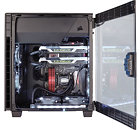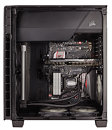Tuesday, December 8th 2015

Corsair Unveils its First Inverted-ATX Cases, the Carbide 600Q and Carbide 600C
Corsair, a world leader in enthusiast PC hardware and components, today announced the release of the new Corsair Carbide 600Q and Carbide 600C high-performance PC cases. With iconic minimalist styling, a wealth of sound-deadening features (600Q), a huge clear side-panel window (600C) and distinctive inverted-ATX interior design, the 600Q and 600C continue the Corsair tradition of innovation and excellence in modern PC case design to deliver a no-compromise approach to PC cooling.
Unlike many PC cases which demand enthusiasts choose between noisy, high-airflow ventilation or low-noise, restricted airflow designs, the 600Q and 600C are able to deliver the best of both. The distinctive inverted-ATX internal design places the heat producing components in the direct airflow pathway of the two AF140L 140mm intake fans and single AF140L 140 mm exhaust fan, providing powerful and efficient cooling, with extra wide vents ensuring unimpeded airflow.Specially tuned for low-noise operation, the 600Q and 600C's three included fans have been redesigned for excellent airflow at lower noise levels, with an integrated external 3-speed fan controller allowing users to reduce the fan RPM, further lowering noise with a minimal impact on cooling performance. The result is a no-compromise approach to cooling that delivers fantastic system temperatures at extremely low noise levels.
The 600Q dedication to low-noise continues well beyond fan speeds. High density sound deadening material fitted in the front panel, side panels, and roof works to further mute system noise and ensure that the 600Q is as quiet as it is beautiful.
Clean and minimalist styling that's both eye-catching yet reserved combines with solid steel exterior paneling and a premium finish. The distinctive curved front panel houses two 5.25in drive bays secreted behind a hinged flap, offering full functionality without compromising on looks. Inside you'll find two tool-free 3.5in drive bays and three tool-free 2.5in drive bays integrated into a stylish PSU and drive bay cover. A plethora of cable routing holes, tie-downs and cable grommets make building in the 600Q and 600C easy, so your system can look as good on the inside as it does on the outside.
Available in December from Corsair's world-wide network of retailers and distributors, the Carbide 600Q and Carbide 600C are backed by a comprehensive two year warranty and Corsair's world-wide customer support network.
Specifications
Unlike many PC cases which demand enthusiasts choose between noisy, high-airflow ventilation or low-noise, restricted airflow designs, the 600Q and 600C are able to deliver the best of both. The distinctive inverted-ATX internal design places the heat producing components in the direct airflow pathway of the two AF140L 140mm intake fans and single AF140L 140 mm exhaust fan, providing powerful and efficient cooling, with extra wide vents ensuring unimpeded airflow.Specially tuned for low-noise operation, the 600Q and 600C's three included fans have been redesigned for excellent airflow at lower noise levels, with an integrated external 3-speed fan controller allowing users to reduce the fan RPM, further lowering noise with a minimal impact on cooling performance. The result is a no-compromise approach to cooling that delivers fantastic system temperatures at extremely low noise levels.
The 600Q dedication to low-noise continues well beyond fan speeds. High density sound deadening material fitted in the front panel, side panels, and roof works to further mute system noise and ensure that the 600Q is as quiet as it is beautiful.
Clean and minimalist styling that's both eye-catching yet reserved combines with solid steel exterior paneling and a premium finish. The distinctive curved front panel houses two 5.25in drive bays secreted behind a hinged flap, offering full functionality without compromising on looks. Inside you'll find two tool-free 3.5in drive bays and three tool-free 2.5in drive bays integrated into a stylish PSU and drive bay cover. A plethora of cable routing holes, tie-downs and cable grommets make building in the 600Q and 600C easy, so your system can look as good on the inside as it does on the outside.
Available in December from Corsair's world-wide network of retailers and distributors, the Carbide 600Q and Carbide 600C are backed by a comprehensive two year warranty and Corsair's world-wide customer support network.
Specifications
- Inverse-ATX Layout: With this new layout, airflow is easily directed at the hottest devices in your system; the GPU and CPU, and not wasted on drive cages.
- Sound Damping Throughout (600Q only): Keep your system quiet and cool with high-density sound damping material on side panels, front panel, and top panels. It's so quiet, you'll find yourself wondering if your PC is even powered on.
- Hinged and Latched Full Side Panel Window (600C only): Easily access your components with a single touch - and when closed, enjoy viewing every part of your build through the full size side panel window.
- Steel Exterior: Get rid of those plastic cases - the 600Q and 600C have full steel exterior panels for extra durability and gorgeous good looks.
- Three Included AF140L fans: Great airflow doesn't have to be noisy - the three AF140L fans can push large amounts of air across your hottest devices without that annoying fan hum, and the three-speed fan controller lets you decide exactly how fast they run.
- PSU and 5.25" Bay Cover: Clean up the inside of your case by tucking all those cables and less-attractive drives behind a clean, refined PSU and 5.25" bay cover. Or remove them for assembly - it's up to you.
- Watercooling Ready: Fit up to a 280mm radiator up front and up to a 360mm radiator on the bottom - along with a 140mm rear fan mount.
- Easy to Clean: Easily access dust filters on front and bottom meaning you'll never spend more than a minute getting dust out of your system.
- Easy to Build: Tool-free drive installation, tool-free side panel access, and tons of cable routing options and tie downs means you can spend less time building your PC and more time using it.
- MSRP: $149.99 exc. Tax





66 Comments on Corsair Unveils its First Inverted-ATX Cases, the Carbide 600Q and Carbide 600C
Because heat rises.
win some lose some..
trog
getting back to 90's & top loading PSU for heat ingestion?
...
Then again, a case like this corsair one fills a rather niche market. Not everyone is going to buy one.
Be nice to see a taller one with 120mm fan above the graphics card and reverse the air flow.
It's not like it would have been hard for them to put a grill on top for PSU to suck fresh air in from there.
In this config we see a few advantages:
1) Direct airflow path from the front fans to GPU/CPU without having to get rid of the 5.25" bays completely.
2) Better GPU cooling on GPUs that feature complex heatpipe/vapor chamber designs as they are orientation dependent and work better in this layout typically.
3) Better CPU and CPU VRM cooling if you use the bottom fan as an intake and blow cold air directly across the CPU/VRM area. Yes, there is a dust filter for this.
4) You can see the sexy cool part of your graphics card instead of the boring PCB. :)
It's not for everyone, of course. But I highly recommend you guys keep your eyes peeled. There are real advantages to the Inverse ATX layout. Some people won't dig it, that's cool.
But the cooling/noise ratio of this layout is simply awesome.
Also I happen to like the looks, but I understand some people don't. That's why we have ~20 other cases. :)
:shadedshu: I feel like the marketing department didn't consult with the people who designed this case. In order for this case to work correctly, the amount of air coming in has to be greater than the amount of air taken out - there must be "excess" air to move across the GPU's and out the back (notice the vented area behind the GPU's) as well as air for the PSU. As pictured in the 2 GPU setup above, there are more fans blowing out than in, so the PSU fan ends up fighting for air, as well as the GPU's sitting in a dead air area.
As for "heating up the PSU", quality PSU's are made to run in 40-50°C ambient temps, so this shouldn't be a problem.
Now if a person added to the 140L intake fans by putting 2 x 140L or 3 x 120L fans on the bottom blowing in, then I could see this case performing wonderfully and quietly. (see below)
IMHO, this case should be limited to about 400 watts of CPU and GPU, such as a mainstream i7 with a pair of GTX 980's.
Why the solid top? Simple answer - noise. Also, I have some friends who have birds roaming free :rolleyes: in their house. Solid top is a very good idea for them.I'm not finding that??????
From kitguru.net: (The PSU is a Seasonic Platinum Fanless 520W!!!!)
@Corsair George , why are you guys marketing this case in a way that users are bound to have a poor experience with it?
I'll keep my PSU sucking cool air in through the filtered bottom until you personally run your own PSU in 50C temperatures 24/7 until it breaks...which will be before mine does.
on some cases you can take advantage of full desing for better airflow for motherboard and other hardware...
The PSU is almost an entirely self-contained system. It has its own cooling, its own temperature and fan control, and its own OCP, OTP, OVP, etc. It is one of the most durable parts of your system and can handle tons of different things.
By flipping the whole thing upside down you end up increasing the temperature of incoming air from ambient (external) to ambient (internal). So, say your room is 25C, and the internal of your case is 35C, then you just raised the ambient 10C. But if your PSU is designed to operate at 50C, that has almost no relevance.
You are right about one thing - the lifespan will decrease shortly based on that temp. If it lasts, say, 70,000 hours @ 50C, then it might last 100,000 hours at 25C, and 85,000 hours at 35C. I honestly don't know the derating curve off the top of my head, but you have the theory correct - it's just that in practice it will make nearly no difference.
And like I've said other places - we do sell a ton of regular layout ATX cases if you'd rather have a 750D or something. :)
is better for a PSU to breath fresh air than hot air from CPU cooler...
regards...
source
I'll keep my PSU with fresh air. But I can't argue with choice. Choices are good for those that want them.
Also not a fan of Corsair's plastic SSD caddies, as they make the drives rattle around in them due to not being designed for 7mm height drives.
And please, no top mounted ports, they collect crud like crazy, one of the big flaws with my old Lian-Li case.
Also, £150 is way too steep, when you consider the exchange rat is 1.5 to the US$...